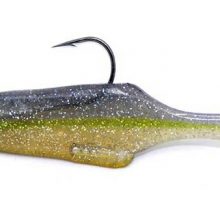This article may contain affiliate links. If you make a purchase after clicking on a link we may earn a small commission at no extra cost to you. As an Amazon Associate, I earn from qualifying purchases.
How to Fish a Swimbait

The number of swimbait designs and manufacturers has exploded since they were first championed in California in the 1990’s.
Since then bass anglers all over the country have come to embrace the swimbait as one of the best choices for targeting really big bass.
But a lot of anglers still ask the question: How to Fish a Swimbait ?
How you fish a swimbait will vary depending on the time of year and where the bass are most likely to be found. Low and slow through the water where the bass a holding.
Shallow water summer fishing will need a different approach to deeper pre-spawn season swimbait fishing.
Size and color/pattern will also play an important role but location is the first thing to get right. The best swimbaits for bass will match the hatch so to speak in terms of what patterns to use.
I like to start with a simple shad pattern and work from there.
Once you have settled on a location that is likely to hold big bass then you can figure out what kind of depth you need to be fishing a swimbait at.
How to Fish a Swimbait
A swimbait should be fished with a low and slow retrieval, running a swimbait too fast will result in it rolling on itself and spoiling the natural swimming action that is built in to it.
You can cover a lot of water when swim bait fishing and if you are not familiar with the venue on which you are fishing the using a fan like pattern with your casts can allow you to tackle a large area before moving on.
Look to run the swim bait along underwater structures or drop offs and weed beds.
One of the best swimbait fishing tips I ever received was to try and find where the shad were moving through as you can be sure that large bass will not be far behind them.
1. Deep Water Swimbait Fishing
During the pre-spawn season when bass will stay down in the deeper waters and this really is were you need to target them.
At this time of year with lower water temperatures bass will try to expend as little energy as possible, meaning they are less likely to chase a lure that is moving too fast or is too high up in the water column.
I like to use a heavier swimbait that has a decent amount of built in weight. that way you get down into the deeper water quicker and it is easier to keep them there as you work them forwards.
A slow retrieval rate is crucial when working swimbaits for bass in colder months. They quite simple will not chase anything if it traveling too fast.
So low and slow is the name of the game even though it an be a little boring at times.
2. Mid Water Swimbait Fishing
I consider the mid range of the water column to be between 3 and 5 feet. Ideally you will target a structure like a submerged log pile and cast a swimbait just beyond it.
Using a slow sinking swimbait you can gauge at what point it sinks to roughly the four foot mark and then start to haul it in slowly.
Occasionally pausing to allow it to sink a little as they will rise as they move.
3. Shallow Water Swimbait Fishing
As temperatures start to rise and bass move towards the shallow you need to start to target them in by running your swimbaits in shallow waters particulary across the tops of sunken logs or branches and large weed beds and lilies.
When casting a swimbait in shallow water with a lot of weeds around it is best to use a weedless hook or a swimbait that has it’s hook mounted on the top.
This types of lures can greatly increase you chances as when weed fouls on some swimbaits it can affect the swimming motion.
Tackle Considerations
Fishing a swimbait is basically cast and retrieve all day long so you will have a much easier time using a casting setup.
Spinning setups are fine for really small finesse style swimbaits but for almost everything else a baitcasting rod is a real must.
Rod
All swimbait rods share one thing in common and that is a fast action. You should look for a rod that has a medium to heavy power rating and should be roughly 7 to eight feet in length.
Reel
If you are using a baitcasting setup then your choice of swimbait reels should match the size of the rod and line that you are using. As long as it has a quality drag and decent casting performance you should be good.
When fishing very large swimbaits you may need to beef your reel up a little and your rod too, this may call for a specialized rod and reel.
Line
The chose of fishing line for swimbaits these days is usually a modern fluorocarbon line with a breaking strain that is normally in the 15 to 20 pound range.
If fishing in shallow waters then monofilament is just as good as it does tend to float a little better than fluorocarbon.
